|
1990 - Commodore 64 Games Systems (64GS) |
 |
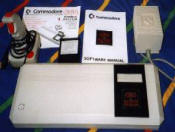 |
In 1990, Commodore set their attentions on the videogame console market. They followed the
same concept as other computer companies (Fujitsu with the FM Towns Marty, and before that the Amstrad GX4000 and the Amiga CD32). Their new system was called the Commodore 64GS (GS = Game System). This unit was basically just a repackaged Commodore 64 computer
without a keyboard, port access (Disk drive, etc), or standard ROM chip. Cartridges were loaded through the top port, and the machine
came packaged with a joystick and a couple of games.
Read more... |
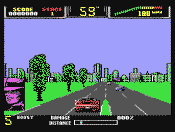 |
|
1990 - SNK Neo Geo AES \ MVS |
   |
_Front_small.jpg) |
SNK took a gamble and created a home version of the MVS in 1990. The NEO GEO AES was
released at a high cost of $650, and came with either Baseball Stars Professional or NAM 1975. Other game cartridges came at a cost
as high as $200 a piece. These cartridges played the exact same software as its MVS counterpart, but were quite expensive due to the
game's high ROM capacity requirements and large PCM boards.
Read more... |
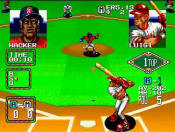 |
|
1990 - Amstrad GX4000 |
 |
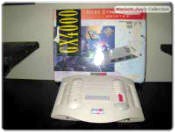 |
The GX4000, released in the UK in 1990 by Amstrad, is definitely one of the most unique
looking video game consoles ever released. Amstrad, a popular computer manufacturer, looked to cash in on the lucrative video game
console market like many of its peers had attempted to do, some more successful than others. Sporting a very sleek design that
resembles the snow speeder in Star Wars, looking underneath the hood of this console reveals anything but space-age technology at the
time of its release.
Read more... |
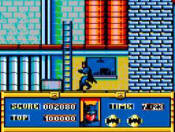 |
|
1990 - Nintendo Super Famicom \ SNES |
      |
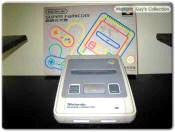 |
In 1988 Nintendo was still enjoying the success of its NES \ Famicom system and didn't
see any need to jump on the 16-bit bandwagon. However the NEC PC Engine / TurboGrafx in Japan and the Sega Genesis in the US were
beginning to dominate the videogame market. Nintendo's jump to 16-bit was no real surprise. Oddly enough Nintendo wanted the original
Famicom to be 16-bit, but resources at the time were too expensive to make it happen, but now was the opportunity to take Nintendo to
the next level.
Read more... |
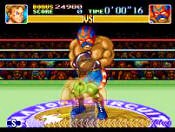 |
|
1991 - Philips CD-i |
    |
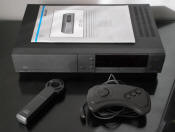 |
In the mid 1980s Philips and Sony partnered up to create a new CD standard containing
interactive combinations of sound, images and computer instructions. This CD standard also required specific types of players. So in
1991 Philips created the Philips CD-i 210 as a "multimedia" system capable of playing interactive CD-i software discs, Audio CDs, CD+G
(CD+Graphics), VCDs (Video CDs), and Karaoke CDs. You could essentially enjoy different types of media on the same machine.
Read more... |
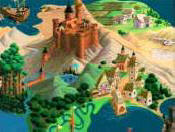 |
|
1991 - Commodore CDTV |
   |
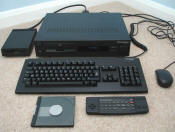 |
In 1991, Commodore once again attempted to enter the video game hardware arena by 'consolizing'
yet another one of their existing line of PCs - the Amiga 500. This new multimedia entry was called the Commodore CDTV (Commodore
Dynamic Total Vision). This system was designed to essentially be the all-in-one unit for your home entertainment. The housing itself
is designed to fit in your standard AV cabinet (at the time).
Read more... |
 |
|
1991 - Fujitsu FM Towns Marty |
 |
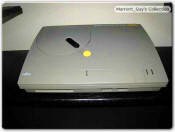 |
The Fujitsu Company decided to make an attempt to penetrate the console games market by
taking their popular FM TOWNS line of computers, and adding in some special components to create a stand alone video game console. The
plan was for the software designed for the FM TOWNS computers to be modified slightly so that the games would work on both the
computer and the console. The FM Towns Marty has the distinction of being the first 32-bit video game console.
Read more... |
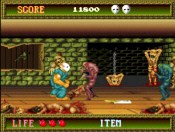 |
|
1991 - NEC PC Engine Duo (TurboDuo) |
   |
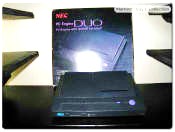 |
The NEC PC Engine Duo kind of started the craze by licensed manufacturers to develop systems
capable of backwards compatibility. NEC had already in its arsenal 4 different types of media format in its stable - HuCards, CD-ROM2,
Super CD and Arcade CD-ROM. The release of this line allowed the gamer to experience basically the entire library that NEC consoles
had to offer - but at a steep price (even to this very day).
Read more... |
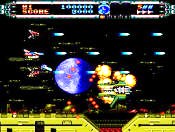 |
|
1991 - Sega CD \ Mega-CD |
      |
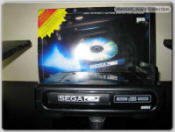 |
In 1991 at the Tokyo Toy show in Japan, Sega unveiled its secret project to compete against
NEC's PC Engine CD-ROM add on. The Mega-CD like its rival was capable of utilizing the enormous storage capacity of CD media to
produce quality games. The Mega-CD however was designed with its own processor and memory that worked in conjunction with the Mega
Drive's (Genesis) processor and memory via an interface port.
Read more... |
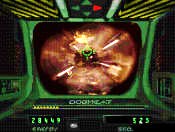 |
|
1992 - Memorex VIS (Tandy Visual Information System) |
 |
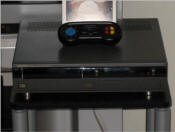 |
In 1992 another multimedia gaming machine arrived silently on the market. The Tandy Video
Information System (VIS). The VIS supported CD-ROM based educational video game software and audio compact discs, and offered an
optional modem for connection to online services. Tandy sold the device with the concept "MANY OF THE BENEFITS OF MULTIMEDIA WITHOUT
HAVING TO PURCHASE A COMPUTER".
Read more... |
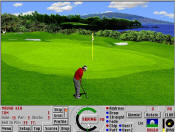 |
|
1992 - Victor Wondermega \ JVC X'Eye |
   |
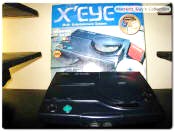 |
JVC had helped Sega by delivering the most advanced sound made by a gaming console. A wider
range of sounds not only gave the CD games more of an impact, but it was better then most audio CD players at the time. In return for
their work, Sega gave JVC the "OK" to create this console. This system could play both Sega Genesis carts and Sega CD games in a
single unit.
Read more... |
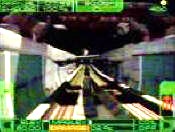 |
|
1993 - Pioneer LaserActive |
  |
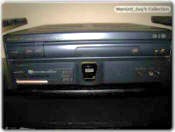 |
In 1993, Pioneer entered the foray with the release of the LaserActive. Competing directly
with Panasonic (3DO) and the Philips (CD-i), Pioneer upped the ante in this genre by basing their system on Laserdisc technology (the
precursor to the DVD format). At the time, the LaserActive was the closest system to deliver a product that did meet most of the
multimedia demands of the consumer - movies, games, karaoke, music, edutainment - all presented in the best audio\video quality
available.
Read more... |
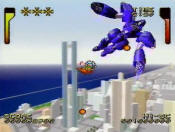 |
|
1993 - Amiga CD32 |
  |
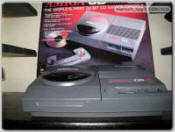 |
Commodore, the noted home computer manufacturer of the 1980s, had endured failed attempts
entering the video game console market with their releases of the Commodore 64 GS and the Commodore CDTV systems. Their final attempt
at capitalizing in the very profitable hardware arena was the Commodore Amiga CD32, debuting in the UK in 1993. The CD32 was marketing
as being the first 32-bit CD-ROM based system (though the FM Towns Marty, released in Japan in 1991 actually owns this true
distinction) and enjoyed moderate success in the UK.
Read more... |
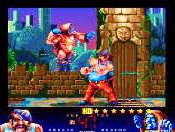 |
|
1993 - Panasonic 3DO |
     |
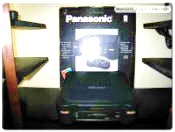 |
The 3DO REAL Interactive Multiplayer (3DO) system is one of those consoles that is either
loved or hated by those in the gaming community. Released by Panasonic in September of 1993, this new gaming machine was one of the
first entries within the 32-bit gaming era. The developer, The 3DO Company, was created by Trip Hawkins, co-founder of Electronic
Arts. Their aim was to create the first 32-bit system that truly delivered a 3D gaming experience. On many levels they achieved this
objective and were successful in pioneering technological advances.
Read more... |
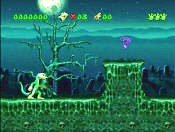 |
|
1993 - Atari Jaguar |
     |
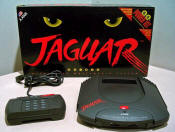 |
With Sega and Nintendo battling neck and neck with their 16-bit platforms, Atari seized the opportunity
to return to the console market after 7 years. A small company calling themselves 'Flare 1' were on the verge of developing a
multiprocessor console. Needing the funding to develop it further, they approached Atari Corp. Atari was trying to develop their
own console code named 'Panther' at the time. They jumped on the offer, and development for the 'Flare 2' continued alongside
the 'Panther'.
Read more... |
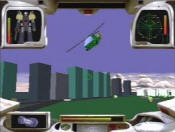 |
|
1994 - Bandai Playdia |
 |
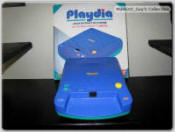 |
The Playdia Quick Interactive System was one of Bandai's next attempt at entering the
videogame console industry. It was released in 1994 in Japan only and marketed as a family oriented system. Geared toward a younger
audience, the Playdia was somewhat smaller then most consoles. Its blue casing giving it a more "toy" feel. The Playdia controller
used infrared waves instead of cords and was made to be used either on or away from the machine.
Read more... |
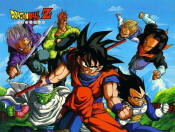 |
|
1994 - Capcom CPS Changer |
 |
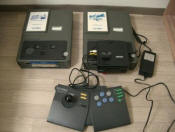 |
In the 1990s, SNK took a chance at bringing their arcade games to the home console market
by creating the Neo Geo AES system. The home system garnered a niche fan base despite its high price tag. In 1994, Capcom saw an
opportunity to venture into this niche home market. Gamers enjoy popular arcade titles without Capcom having to pay royalties for
"lower quality" home conversions on other systems. Not a bad idea!
Read more... |
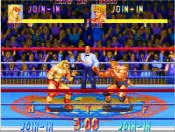 |
|
1994 - NEC PC-FX |
 |
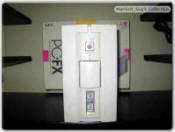 |
The NEC PC-FX is a very Japanese console. As the follow up effort to the highly successful
(at least in Japan) PC Engine, NEC was looking to hit one out of the park with gamers. Unfortunately, their efforts were too little
too late and the PC-FX ended up being little more than a footnote in the history of video gaming. The PC-FX was originally developed
in 1992 as the Iron Man, but due to the continued success of the PC Engine and the developers disinterest in changing platforms, it
was shelved until 1994 when it was released to compete with the 3DO.
Read more... |
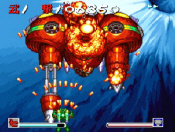 |
|
1994 - Sega 32X (Super 32X, Mega 32X) |
     |
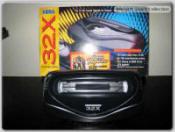 |
It was the winter of 1994, and new more powerful consoles were entering the videogame
market. Gamers were enjoying new 3D arcade games, and the 16-bit Genesis / Mega Drive seemed to be feeling its age. It was January 8th
1994 when Sega CEO Hayao Nakayama directed his company to produce a 32-bit cartridge-based console to be in stores by Christmas 1994. The project was dubbed Jupiter.
Read more... |
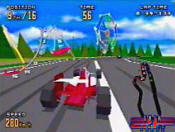 |
|
1994 - SNK Neo Geo CD \ CDZ |
    |
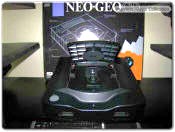 |
Through the 1990s SNK was ruling the arcades. Their cartridge based Neo Geo AES made their
arcade hits playable at home, but the high price tag kept it out of the hands of many gamers. With other consoles switching game
formats, SNK saw an opportunity to also use the large storage capacity of CD to make their hit games cheaper to manufacture. Of course
this would make games more affordable to the general gaming public. In 1994, SNK released the Neo Geo CD in Japan (and shortly after
in the U.S).
Read more... |
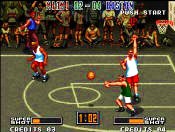 |
|
1994 - Sega Saturn |
     |
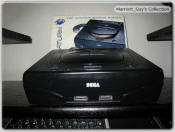 |
In development for 2 to 3 years by Sega of Japan, the project known merely as GigaDrive (a
word play for a more powerful Megadrive) began with a goal of being the most powerful 2D console to date with 3D capability based on
their arcade Model 1 hardware. Initially the goal was to surpass another CD-based console called the 3DO. In November of 1993,
technical specs for 32-bit CD-based console by Sony had surfaced. Not being pleased with the projects 3D capability (compared to
Sony's), Sega of Japan's engineers scrambled to improve on the design.
Read more... |
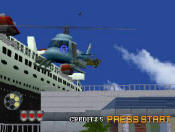 |
|
1994 - Sony PlayStation |
      |
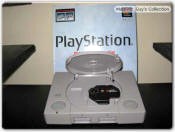 |
Japanese electronics company Sony's involvement in the videogame industry began as a
manufacturer of a custom sound chip used in Nintendo's SNES console. Rival companies NEC and Sega had taken the leap to CD based
gaming and Nintendo had no intentions of being left behind. They immediately partnered up with Sony to develop their CD based system. Sony went on to develop two units. One was a 16-bit add-on for the Super Famicom / SNES that sat underneath the system and allowed CD
based gaming (SNES CD).
Read more... |
 |
|
1995 - Bandai Pippin ATMARK (@WORLD) |
   |
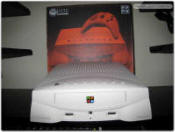 |
In 1995, Apple Computer Inc. joined the foray by finishing the development of a system based
on a scaled down version of their System 7 OS. Named the Pippin, Apple followed the 3DO Company's lead by licensing this technology to
an outside manufacturer - Bandai Digital Entertainment. The Bandai Pippin ATMARK was released in Japan in 1995 and was marketed as the
first modern hybrid console merging the power of a computer with the ease of a gaming station - as well as integrated network
capabilities (hence the connotation in the name).
Read more... |
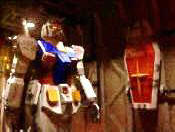 |
|
1995 - Casio Loopy (My Seal Computer) |
 |
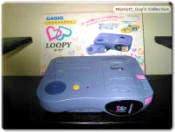 |
Casio of Japan had crashed and burned in console gaming with the Casio PV-1000. However in
October of 1995, they decided to attack the market from a different angle. The marketing strategy focused on girls. Lousy marketing
executives from other companies have tried to interest females in the past by selling their consoles in more feminine shades of color
(Master System, Zemmix, Twin Famicom, Lady Cassette Vision and a few others had girly pink colored versions of their consoles).
Read more... |
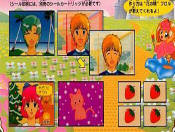 |
|
1995 - Nintendo Satellaview BS-X |
 |
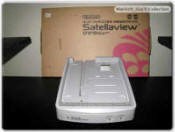 |
The Satellaview was not really a console, but was an interesting add-on for the Super
Famicom. It was licensed by Nintendo and was released in Japan in 1995. It cost 14,000 yen (about $150) and a subscription fee had to
be paid monthly to use the service. The unit sat under the Super Famicom and was the only device to utilize the port found underneath
the console. It connected to a satellite channel called St. GIGA and allowed subscribers to download games, demos, news, interviews,
and whatever else Nintendo felt like offering.
Read more... |
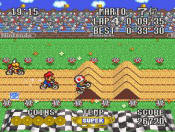 |
|
1995 - Atari Jaguar CD |
  |
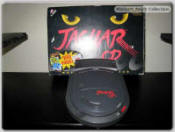 |
In 1995 Atari finally wised up and created a CD-ROM add on to tap the 700+ megabit CD
format. The Jaguar CD retailed for $150, and came equipped with a double speed CD-ROM capable of running Jaguar games, Audio CDs and CD+Gs. Games could run full motion video at 24 frames per second. The Jaguar CD also featured a built in Virtual Light Machine (color
and visual effects that react to the music and sounds).
Read more... |
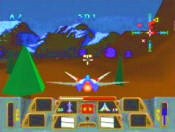 |
|
1995 - Nintendo Virtual Boy |
   |
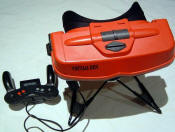 |
Like the Adventure Vision back in 1983, Nintendo utilized LED technology in their Virtual
Boy. Nintendo proclaimed that they had achieved a true 3D perspective with this new console, but in truth what they created was
a headache generator. The system was pretty much a failure on all levels and was discontinued within one year of its release.
Read more... |
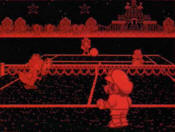 |
|
1995 - Funtech Super A'Can |
 |
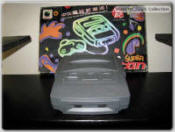 |
In 1995, Funtech Entertainment Corporation released the first original gaming system in
Taiwan - the Super A'Can. Produced and sold exclusively in its native country, the console and controllers feel very fragile,
constructed of thin plastics that belies its strong, dark grey outwardly appearance and extremely high price tag. This system is often
mistaken as a Super Nintendo Entertainment System clone due to both the physical design and the processor powering this unit. A closer
inspection of this rare oddity reveals a different picture.
Read more... |
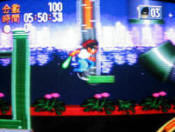 |
|
1996 - Nintendo 64 |
      |
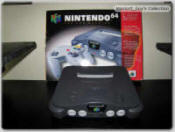 |
Nintendo stretched the life of their 16-bit console for as long as they could. Their initial
attempts at entering the market with a 32-bit CD add-on (see PlayStation) never saw the light of day. After the releases of Sony and
Sega's 32-bit systems, Nintendo began spreading the word of their new console in development. The leap to a 64-bit console became
known as Project Reality. The system was a joint venture by Nintendo and Silicon Graphics. Nintendo would later change the name to
Ultra 64.
Read more... |
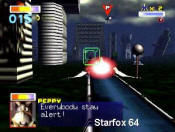 |
|
1998 - Panasonic 3DO M2 |
 |
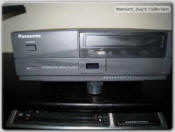 |
Two years after the release of 3DO, the company began working on it's successor codenamed
Bull Dog (model FZ-DR21 - the external drive unit for the development kit). At first, M2 began as 64-bit add-on for 3DO systems. The
concept was initially developed by the same people responsible for the first 3DO system (called Opera). Later around 1995, 3DO sold the
technology to Matsushita and left the hardware market. The Japanese electronic giant worked on the base of the system to produce a
better technology called M2.
Read more... |
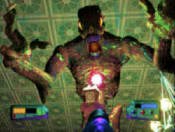 |
|
1998 - Nintendo 64DD |
 |
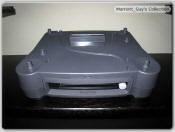 |
Nintendo chose to continue with
the cartridge format, but wanted to do something to compete with
the CD-ROM storage capacity being used by rival game systems. Their solution was the Nintendo 64DD. The Nintendo 64 Disk Drive was the
first writable bulk data storage device for a video game console. Using a 64-megabyte writable magnetic disk media, it would allow
game developers freedom to store unprecedented amounts of gaming data on a console machine.
Read more... |
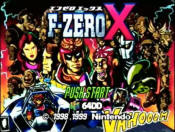 |
|
1998 - Sega Dreamcast |
     |
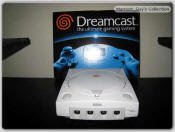 |
Around March 12th, 1997 rumors began to surface about what began as a 64-bit upgrade for the
Sega Saturn. Eventually news began to leak about Sega's development of a totally new console. By June 1997, Sega had two different
design specs under consideration to become the new console. One design was code-named Black Belt and the other Dural. Black Belt was
being designed by Sega of America. The console would sport an IBM/Motorola PowerPC 603e CPU with 3Dfx Voodoo graphics chipset.
Read more...
|
 |
 DISCUSS
DISCUSS